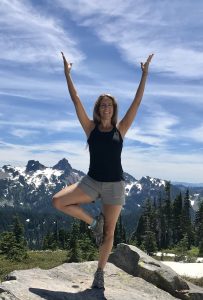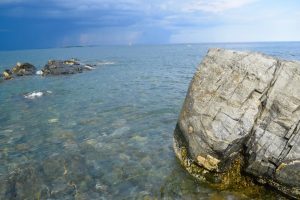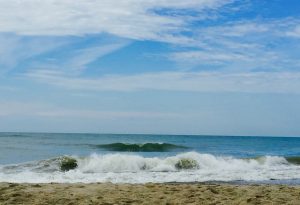 As I sit and write this blog, the rain is coming down. The rain absorbs into the plants and Earth and supplies its liquid goodness to the aquifers in the ground promoting life above. Earth is a water planet and our bodies are 70% water. We started our beginnings in the amniotic sea of life and we need this precious nectar for survival.
As I sit and write this blog, the rain is coming down. The rain absorbs into the plants and Earth and supplies its liquid goodness to the aquifers in the ground promoting life above. Earth is a water planet and our bodies are 70% water. We started our beginnings in the amniotic sea of life and we need this precious nectar for survival.
There’s something magical about water. I grew up surrounded by it and even today, I feel relaxed when a body of water is in my presence. From a stream to a lake and from a river to the ocean, I love them all! I am not the only one who believes in the benefits of H2O.
Hydrotherapy, water therapy, is the use of water to improve health. This form of therapy has been utilized dating back to 4500 BC and it is an integral element in traditional medicine systems, European health care and even in the United States as John Harvey Kellogg believed in water’s healing properties. Yes, he did make cereal too! When I was in my doctoral program studying naturopathy (natural medicine), we discussed water use in detail from its solid form (ice) to cold, hot and steam. It’s been used to relieve stiffness, swelling, pain and promote overall health and well-being. In fact, Franklin D. Roosevelt used warm outdoor mineral springs to assist with pain and paralysis from polio.
Hydrotherapy stimulates the immune system and helps improve lymphatic flow. It can alter blood circulation to areas of the body as well. It has been used in specific hydrotherapy clinics to assist with varied ailments and promote detoxification and open the flow of the meridians discussed in Little Life Hacks: A River Runs Through Us.
areas of the body as well. It has been used in specific hydrotherapy clinics to assist with varied ailments and promote detoxification and open the flow of the meridians discussed in Little Life Hacks: A River Runs Through Us.
As with anything, general caution should be made for certain groups such as individuals with diabetes who should not apply high levels of heat to their feet. This also applies to anyone with compromised circulation in the extremities such as those with Raynaud's syndrome. In these cases, a towel drenched in very warm water and then wrung out can be utilized. Make sure you read this entire article throughout before trying one of the mentioned methods. This will ensure that it’s right you.
How can you use hydrotherapy at home? Below are instructions. Go back to the previous article Little Life Hacks: Dry Brushing where I discussed dry brushing. There we discussed improving circulation and then showering with cool water and then warm. You can take it to a whole new level with hydrotherapy. I will address each method below from easiest method to more intense. This way you get to decide for yourself.
Hot Bath – You just performed a little dry brushing and you showered with cool water. While you were drying brushing, you were running a hot bath (remember the cautions mentioned above). I know this isn’t water saving but it is therapeutic. The recommendation after a hot bath is to jump in a cold shower for 2-3 minutes (or however long you can do it). Why cold? The cold activates and seals in the parasympathetic nervous system and assists the body in repair, recovery and relaxation.
- Side note - I did this in January 2018 when I woke up with body aches and chills. I knew something was off and had a low-grade fever. I dry brushed, cool shower and jumped into a hot bath filled with liquid
 magnesium, Epsom salt and eucalyptus essential oil. I drank lots of water while in it (not the bath water, but a extra large glass of quality water). My hope was to bring my fever up and let my body burn up whatever sickness was coming on because that is what a fever is designed for. It worked and I knew symptoms and signs to look for to ensure my fever wasn’t too high so I’m not suggesting that you do this. I’m merely telling a story. After 25 minutes, I got out of the bath, dried off, put some cozy pajamas on and slept. I was much better and fever free the next day and rebounded quickly.
magnesium, Epsom salt and eucalyptus essential oil. I drank lots of water while in it (not the bath water, but a extra large glass of quality water). My hope was to bring my fever up and let my body burn up whatever sickness was coming on because that is what a fever is designed for. It worked and I knew symptoms and signs to look for to ensure my fever wasn’t too high so I’m not suggesting that you do this. I’m merely telling a story. After 25 minutes, I got out of the bath, dried off, put some cozy pajamas on and slept. I was much better and fever free the next day and rebounded quickly.
Hot Foot Bath – This can assist with a wide variety of ailments from simple tension headaches to upper respiratory infections. I love this method in the evening with a ¼ cup of liquid magnesium and a splash of lavender essential oil to improve sleep and relaxation.
- Prep: You will need a large glass bowl or even a deep casserole dish (if you don’t have a foot bath) and a towel.
- Fill the bowl with enough water to cover the ankles. The water should be as hot as you can comfortably stand. Soak the feet for 10-15 minutes. More than 15 minutes of heat exposure promotes congestion and if you have a headache or are stuffy, you don’t want more congestion. If you don't have a headache and simply want relaxation, longer than 15 minutes is fine.
- For a more powerful method, alternate between a hot water and cold water foot bath, every five minutes and repeating up to three times. Always end with cold water. This will take ~30 minutes total.
Contrast Specific Hydrotherapy – Alternating between hot and cold applications to specific areas of the body can increase circulation and decrease congestion. From the Classical and Traditional Chinese Medicine (TCM) perspective, congestion or stagnation cause pain and this is due simply from the lack of flow in the body. This method can be employed to reduce discomfort, swelling and pain associated with acute injuries, headaches, ear pain and other conditions.
can increase circulation and decrease congestion. From the Classical and Traditional Chinese Medicine (TCM) perspective, congestion or stagnation cause pain and this is due simply from the lack of flow in the body. This method can be employed to reduce discomfort, swelling and pain associated with acute injuries, headaches, ear pain and other conditions.
- Prep: You will need a large bowl of hot water and two towels. You will also need a large bowl of cold water with ice cubes. In addition, you’ll need a plastic sheet or old shower curtain to protect the chair (wherever you plan to sit down for this).
- Begin with a 3 to 5-minute hot application (towel dunked in hot water and wrung out). Note: check the towel before applying. If it’s too hot, hold it and wave it back and forth for a couple of minutes to cool it down. Apply the towel to the area of the body you’re focused on. Leave on one minute.
- Do the same for the cold application (towel wrung out in cold tap water or ice water) and place on the affected area. It’s one minute on for each and repeat this at least three times. Always end with a cold application. The application cycle takes ~30 minutes.
- Note: For children, elderly and severely debilitated individuals, use moderate temperature extremes.
Constitutional Hydrotherapy – This therapy is often combined with other modalities such as sine wave or diathermy in official clinics. This is a modification of the original hydrotherapy that originated in Germany a century ago by the original naturopaths. You can create your own method at home and it is quite a lengthy process so here it goes…
- Prep: You will need a shower or bathtub. You’ll also need one towel, one sheet and two blankets. You also need a plastic sheet or old shower curtain.
- Place the plastic or old shower curtain on the bed. Spread the blankets lengthwise on the bed with a sheet over them.
- You will need a towel that has been dunked in cold water. Wring out the excess water so the towel is damp but not dripping and place in a sink or location so it’s not dripping on floor and you don’t slip or fall.
- Take a hot bath or shower for 5 to 10 minutes. Your body should feel warm after this. If not, stay a little longer until you do feel warm. Get out of the shower/bath and dry legs off quickly.
- Wrap the cold towel all the way around your trunk. Some people prefer to keep their towel in a sink of cold water and wring out after they get out of the shower. Walk safely and lie down on the blankets that you prepared ear
 lier and wrap the sheets and blanket snugly around you like you’re swaddled. You can rest, meditate and just chill “literally” for about 25 minutes or until your body has warmed the towel. Done! Get dressed or in pajamas and try to relax after this session since you will be calm and serene…at least I hope so.
lier and wrap the sheets and blanket snugly around you like you’re swaddled. You can rest, meditate and just chill “literally” for about 25 minutes or until your body has warmed the towel. Done! Get dressed or in pajamas and try to relax after this session since you will be calm and serene…at least I hope so. - Note: See the notes before about who this isn’t recommended for. If you have asthma or a low oral body temperature already (below 97 degrees Fahrenheit) avoid drafts during this session by applying a warm blanket or even a hot water bottle to the feet.
One last thing...maybe you’re already into contrast hydrotherapy and have a hot tub and an outside chest freezer that you submerge in. Perhaps you’re a fan of Wim Hof, the Iceman. Whatever the case, always consult with your health care provider before to ensure that hydrotherapy is right for you.
If you’re new to this or these methods, start with small areas and gradually increase the cold (since cold seems to be the real challenge with contrast hydrotherapy). I personally turn the temperature in the shower up and down to create my “quick access” contrast hydrotherapy. Remember, modify as needed. You can substitute a hot water bottle for a hot wet towel. You can use a frozen bag of peas in place of a cold wet towel. Enjoy your experience and try something new. The foot bath is a must for me and one of my favorites that invites calm and serenity into my evening. Of course, I open up my apothecary of essential oils (EOs) to seal the deal into my dream state. As we continue this series, I'll discuss more regarding the benefits of EO use in everyday life and other curious natural modalities for well-being. Thanks for joining me for this article. Check out the series from previous month in 2021. Hope you find your water bliss this month!
create my “quick access” contrast hydrotherapy. Remember, modify as needed. You can substitute a hot water bottle for a hot wet towel. You can use a frozen bag of peas in place of a cold wet towel. Enjoy your experience and try something new. The foot bath is a must for me and one of my favorites that invites calm and serenity into my evening. Of course, I open up my apothecary of essential oils (EOs) to seal the deal into my dream state. As we continue this series, I'll discuss more regarding the benefits of EO use in everyday life and other curious natural modalities for well-being. Thanks for joining me for this article. Check out the series from previous month in 2021. Hope you find your water bliss this month!

1 Comment
Celeste, thanks for this article. In the winter I'm not brave enough to try the cold after the hot shower. But perhaps in the summer. Wim Hof is amazing.